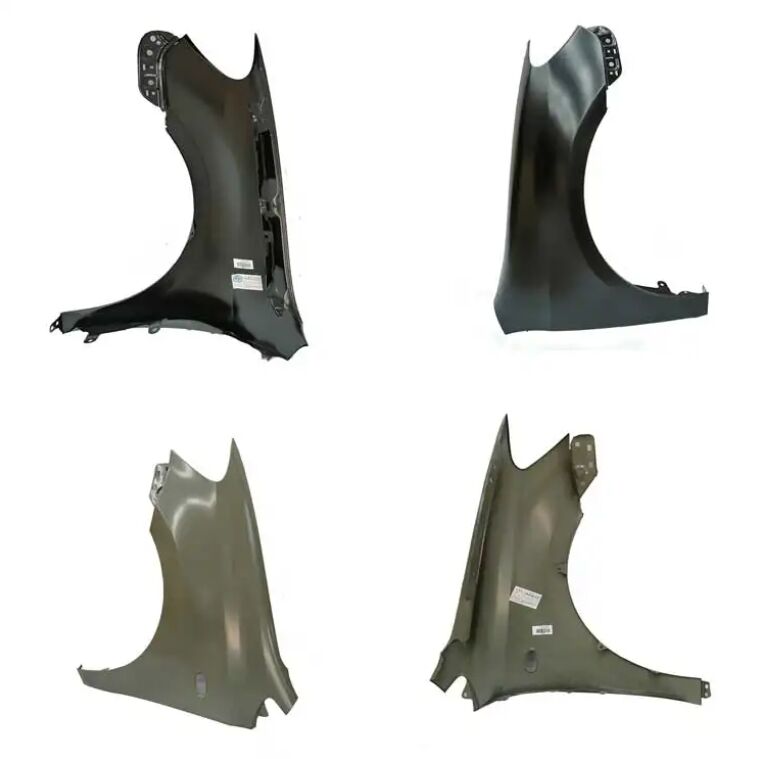Ժամանակակից ավտոմագիստրալներում տրանսպորտային միջոցների պաշտպանության հասկացությունը
Երբ ավտոմեքենան արագընթաց շահագործվում է ավտոմայրուղիներով, այն մշտական ռմբակոծության է ենթարկվում տարբեր տեսակի ճանապարհային աղբից: A հետևի պաշտպանիչ ծառայում է որպես կարևոր պաշտպանական խոչընդոտ՝ պաշտպանելով ձեր ավտոմեքենայի ներկը և մարմինը հնարավոր վնասվածքներից: Այս անհրաժեշտ ավտոմոբիլային բաղադրիչը զգալիորեն էվոլյուցիա է կրել իր սկզբնական դիզայններից սկսած և վերածվել ավտոմեքենայի էսթետիկայի ու պաշտպանության անբաժանելի մասի:
Ժամանակակից հետևի թրթուրների համակարգերը ներառում են առաջադեմ նյութեր և ճարտարագիտական սկզբունքներ, որոնք արդյունավետորեն շեղում են փշրանքները, ծակոտկեղը, ջուրը և այլ աղտը, որոնք հակառակ դեպքում կարող են լուրջ վնաս հասցնել ձեր մեքենայի վերապատմանը: Այս պաշտպանիչ տարրերի աշխատանքի սկզբունքը հասկանալով՝ մեքենայի սեփականատերերը կարող են տեղյակ որոշումներ կայացնել իրենց ավտոմեքենայի տեսքի և արժեքի պահպանման վերաբերյալ:
Ետքի թրթուրի պաշտպանության գիտական հիմքը
Աէրոդինամիկ դիզայնի տարրեր
Լավ կոնստրուացված ետքի թրթուրը աշխատում է ձեր ավտոմեքենայի աէրոդինամիկայի համատեղ։ Կորացված մակերեսները և ռազմավարական դասավորությունը օգնում են ստեղծել օդային հոսքեր, որոնք հեռացնում են աղբը ձեր մեքենայի մարմնի սալիկներից: Այս աէրոդինամիկ արդյունավետությունը հատկապես կարևոր է ավտոմայրուղու արագությունների դեպքում, երբ թռչող աղբից վնասվելու ռիսկը զգալիորեն աճում է:
Ժամանակակից ետքի թրթուրների դիզայնը ներառում է փորձարարական անաերոդինամիկ խցի տվյալներ, որոնք օգտագործվում են ձևը առավելագույն պաշտպանություն ապահովելու համար: Կոնտուրները հաշվարկվում են այնպես, որ նվազագույնի հասցվի շուրջբուլբուլը՝ միաժամանակ առավելագույնի հասցնելով վնասակար նյութերի անդրադարձումը ձեր ավտոմեքենայի մակերևույթից:
Նյութերի տեխնոլոգիայի նորարարություններ
Այսօրվա ետքի թրթուրների համակարգերը օգտագործում են բարձրորակ պոլիմերներ և կոմպոզիտային նյութեր, որոնք առաջարկում են գերազանց պաշտպանություն՝ չավելացնելով ավտոմեքենայի զանգվածը: Այս նյութերը հատկապես ընտրվում են դրանց տևողականության, ճկունության և արտաքին գործոնների նկատմամբ դիմադրության համար, ինչպիսիք են UV ճառագայթումը և ջերմաստիճանի տատանումները:
Նյութերի գիտության վերջին ձեռքբերումները հանգեցրել են ետքի թրթուրների մշակմանը, որոնք կարող են դիմակայել ավելի մեծ մասնիկների հարվածներին՝ պահպանելով իրենց կառուցվածքային ամբողջականությունը: Այս նյութերը նաև դիմադրում են ճեղքվածքներին և քայքայմանը՝ ապահովելով ձեր ավտոմեքենայի ներկի երկարաժամկետ պաշտպանություն:

Գործողության մեջ գտնվող պաշտպանության մեխանիզմներ
Հարվածի անդրադարձման համակարգեր
Հետևի ամպրոպաշերտի հիմնական գործառույթը վտանգավոր մասերին հարվածելուց առաջ ավտոմեքենայի ներկին հարվածող աղբը շրջանցելն է: Ամպրոպաշերտի անկյունը և մակերեսի տեքստուրան նախագծված են այնպես, որ մասնիկներն ու խոնավությունը շրջանցեն խոցելի տեղերից: Այս շրջանցման համակարգը հատկապես կարևոր է, երբ դուք ընթանում եք ավելի մեծ տրանսպորտային միջոցների հետևում, որոնք կարող են ավելի խոշոր ճանապարհային աղբ բարձրացնել:
Գագաթնակետային հետևի ամպրոպաշերտերի նախագծումը ներառում է պաշտպանության բազմաթիվ շերտեր, որոնցից յուրաքանչյուրը կատարում է որոշակի դեր ընդհանուր պաշտպանական ռազմավարության մեջ: Արտաքին շերտը ապահովում է առաջնային հարվածի դիմադրություն, իսկ ներքին մասերը օգնում են կլանել և բաշխել ավելի խոշոր աղբից առաջացած ուժը:
Բարձրացված ամպրոպաշերտի ինտեգրում
Ժամանակակից հետևի ամպրոպաշերտերի համակարգերը հաճախ ներառում են ինտեգրված ամպրոպաշերտեր, որոնք աշխատում են հիմնական ամպրոպաշերտի կառուցվածքի հետ միասին: Այս մասերը ստեղծում են լրացուցիչ խոչընդոտ ջրի ցայտերի և փոքր մասնիկների դեմ, որոնք հակառակ դեպքում կարող էին հայտնվել ձեր ավտոմեքենայի մակերեսին:
Սպլեշ պաշտպանի տարրերը տեղադրված են այնպես, որ առավելագույնի հասցվի ծածկույթը՝ պահպանելով անիվների խոռոչի շուրջ ճիշտ օդի շրջանառությունը։ Այս խիստ հավասարակշռությունը ապահովում է օպտիմալ պաշտպանություն՝ առանց վատթարացնելու մեքենայի աշխատանքը կամ վառելիքի արդյունավետությունը:
Հետևի ամպրոպապաշտպանի երկարաժամկետ առավելություններ
Լաքի պահպանման առավելություններ
Նախատեսված կերպով աշխատող հետևի ամպրոպապաշտպաններով մեքենաները ժամանակի ընթացքում զգալիորեն պակաս լաքի մաշվածություն և վնասվածքներ են ցուցաբերում։ Տրամադրված պաշտպանությունը օգնում է պահպանել գործարանային վերջնամշակումը՝ պահպանելով ձեր մեքենայի տեսքն ու արժեքը։ Ձեր հետևի ամպրոպապաշտպանի համակարգի պարբերական ստուգումը և սպասարկումը կարող է օգնել ապահովել պաշտպանություն տարիներ շարունակ:
Մասնագիտացված մաքրողներն ու ավտոմոբիլային փորձագետները համարյա միշտ ընդգծում են հետևի ամպրոպապաշտպանի կարևորությունը մեքենայի վերավաճառքի արժեքը պահպանելու համար։ Լաքի վնասվածքներից և վերանորոգումներից կանխարգելված ծախսերի տնտեսությունը կարող է զգալի լինել ձեր մեքենայի կյանքի ընթացքում:
Ծախսերի նվազեցում սպասարկման
Հետևի ամպրոնները, կանխելով հողի վնասը, օգնում են նվազեցնել ներկի շտկման և վերանորոգման հաճախադեպությունն ու արժեքը: Այս պաշտպանական գործառույթը հատկապես կարևոր է այն մեքենաների համար, որոնք հաճախ են անցնում ավտոմայրուղիներով կամ այն տարածքներով, որտեղ կա շաղախ և շինարարական գոտիներ:
Որակյալ հետևի ամպրոնների մեջ ներդրումը սովորաբար իր արժեքն անգամ բազմակի է վերադարձնում՝ նվազեցնելով թանկարժեք մարմնի վերանորոգումների և ներկի ուղղման կարիքը: Այն մեքենաների սեփականատերերը, ովքեր պահպանում են իրենց հետևի ամպրոնների համակարգերը, հաղորդում են արտաքին վնասվածքներին կապված ավելի ցածր տարեկան պահպանման ծախսերի մասին:
Հաճախ տրվող հարցեր
Որքան հաճախ պետք է ստուգվեն ետևի թիթեղները վնասվածքների նկատմամբ:
Պետք է կատարել պարբերական ստուգումներ ամենաքիչը յուրաքանչյուր վեց ամիսը մեկ, կամ ավելի հաճախ, եթե դուք հաճախ եք վարում ավտոմայրուղիներով կամ անհարթ ճանապարհներով: Ստուգեք ճեղքերը, ամրացման կետերի ամրությունը և մաշվածության նշանները, որոնք կարող են վտանգել պաշտպանությունը:
Կարո՞ղ են արտադրողից անկախ հետևի ամպրոնները ապահովել գործարանային տեղադրված ամպրոնների նման պաշտպանության մակարդակ:
Բարձրորակ ավտոմեքենայի հետևի թևերը կարող են ապահովել գործարանային տեղադրված միավորներին համարժեք, կամ երբեմն ավելի լավ պաշտպանություն, եթե դրանք ճիշտ են նախագծված ձեր կոնկրետ ավտոմեքենայի մոդելի համար և մասնագիտացված կերպով են տեղադրված:
Ո՞ր նշաններն են ցույց տալիս, որ հետևի թևի փոխարինում է անհրաժեշտ:
Ուշադրություն դարձրեք տեսանելի ճեղքերին, դեֆորմացիաներին, ամրացման ամրության բացակայությանը կամ անսովոր ձայներին վարելիս: Եթե նկատում եք, որ ձեր ավտոմեքենայի ներկի վրա ավելի շատ փոշի կամ աղբ է կուտակվում, սա կարող է նշանակել, որ թևի աշխատանքը խաթարված է և պահանջում է ուշադրություն:

